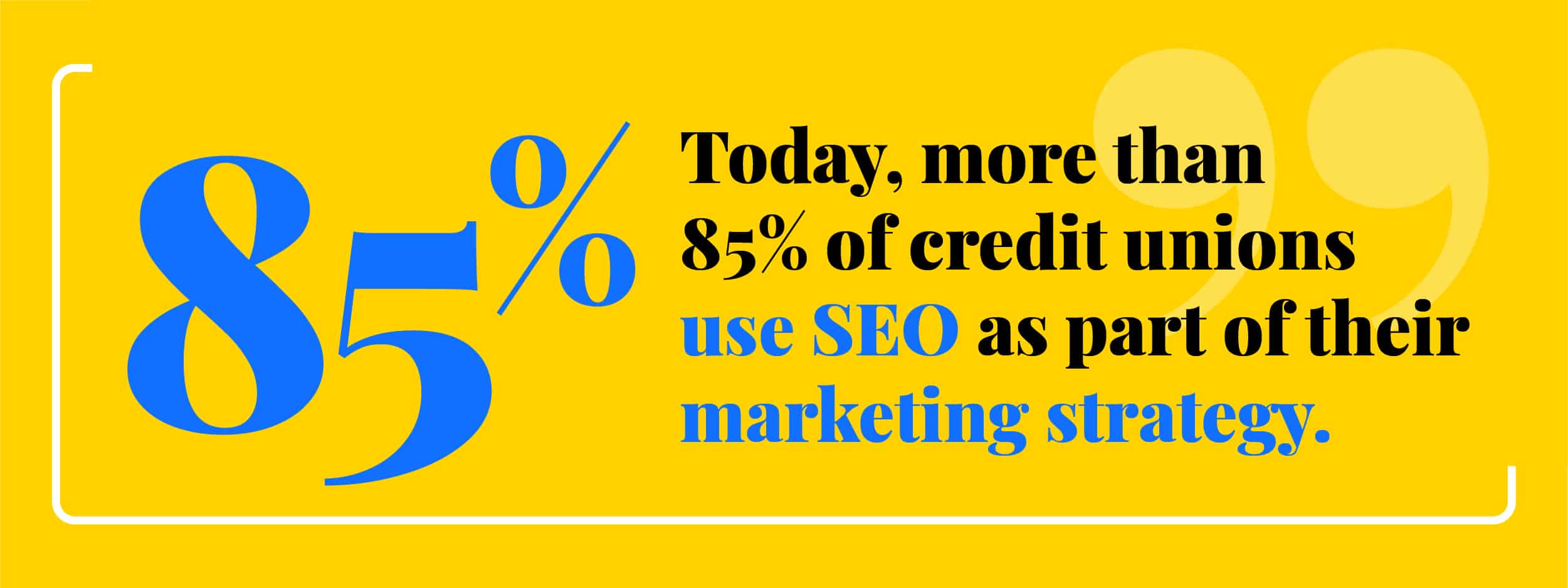The best time optimize your website for search engines is yesterday. The second-best time is now. That’s as true for credit unions as for any other type business.
There’s really no time to waste. Financial institutions of all kinds have already adopted great web solutions to better serve their customers. In order to keep up, let alone get ahead, your credit union needs great search engine optimization (SEO) to reach potential members.
Today, more than 85% of credit unions use SEO as part of their marketing strategy, according to a 2022 survey. What’s more, when credit union marketers were asked which digital channels they considered “very” effective in the same survey, SEO outranked every other category except PPC.

This guide will explain the basics of SEO for credit unions and show you how to build an SEO strategy for your institution. Along the way, we’ll outline best practices, tips, and ideas you can use to drive organic traffic to your website and achieve your credit union’s marketing goals.
In this guide:
Session Interactive has over ten years of experience helping financial institutions achieve their digital marketing goals. Our experience includes SEO management and consulting for major credit unions like Canvas Credit Union.
Our experience as a credit union SEO agency gives us unique insights into what credit unions need to generate leads and conversion from organic search.
SEO Strategy 101 for Credit Unions
Search engine optimization (SEO) is a powerful tool in your credit union’s digital marketing toolkit. With the right SEO strategy, credit unions can increase their visibility on search engine results pages, attract more website visitors, and convert those visitors into members.
SEO can be the best marketing investment a credit union makes over the long term. Over time, returns on SEO investments grow and grow, particularly if the search presence is properly maintained.
In this section, we delve into the general principles of SEO and how they specifically apply to credit unions, laying the groundwork for an effective, long-term SEO strategy.
What Is Credit Union SEO?
Credit union SEO is the process of improving your credit union’s performance on search engines, especially Google. Search engine optimization can help your credit union rank higher in search engine results pages (SERPs) for relevant keywords and phrases. In turn, this can drive organic traffic to your website.
SEO involves optimizing every aspect of your online presence – from content to technical features. Ultimately, the goal is to increase visibility on SERPs, boosting website visitors and ultimately leading to more memberships.
Remember, SEO is a long-term strategy and requires consistent effort and monitoring. By bringing these components together, you can create a comprehensive SEO strategy that delivers results.
What Is a Credit Union SEO Strategy?
An SEO strategy is a plan designed to improve a website’s search engine rankings and increase its organic traffic over time. It involves a series of coordinated actions, including keyword research, content creation, on-page and off-page optimization, plus continuous monitoring and adjusting based on performance metrics.
An SEO strategy plays an integral part in the overall digital strategy for credit unions, by ensuring that the institution’s online presence is in sync with its brand, goals, and target audience. For credit unions, a well-implemented SEO strategy can lead to increased visibility, more qualified leads, and improved member satisfaction.

How to Build a Credit Union SEO Strategy
Building an effective SEO strategy for your credit union requires a systematized approach. This section walks through the generalized steps, providing a roadmap for crafting and implementing a successful SEO strategy for your credit union.
Step 1: Research
The first step in building an SEO strategy is conducting thorough research. Start by defining your target demographic and their online behavior. Use SEO tools like Google Keyword Planner or SEMrush to identify relevant keywords. Choose keywords by balancing search volume, keyword difficulty, and search intent. Study your competitors, identify the keywords they rank for, the type of content they produce, and their backlink profile. This research will form the foundation of your SEO strategy.
Step 2: Goal-Setting
After researching, set measurable SEO goals based on your findings and aligned with your credit union’s objectives. These goals could include ranking for specific keywords, increasing traffic to loan application pages, or improving local visibility. Once established, break each goal into actionable steps. For instance, to rank higher for a keyword like “small business loans near me,” create new content, optimize existing content, or build backlinks from reputable sites. Quantify your goals for easier progress tracking.
Step 3: Planning
During the planning phase, outline specific actions to achieve SEO goals. This includes identifying pages for optimization, creating a content calendar, deciding on a backlink strategy, and setting a monitoring schedule based on performance metrics. For credit unions, focus on optimizing the most visited pages for quick results. This can include improving keyword usage in headings and content or addressing common questions in FAQs.
Step 4: Execution
During the execution phase, implement your planned actions. Optimize existing web pages, create new content based on target keywords, and initiate link-building efforts. For credit unions, prioritize quick wins by optimizing landing pages first. Then, focus on valuable, relevant, and keyword-optimized content creation and backlink acquisition. Collaborate with local businesses and influencers for link-building while targeting high-quality, reputable sites. Regularly monitor performance to gauge effectiveness and adjust strategy as needed.
Step 5: Monitoring and Improvement
Once your changes are made, focus on monitoring and refining. Use analytics tools to track keyword performance, webpage traffic, and progress towards goals. For credit unions, membership growth and member engagement are key indicators of SEO success. Regular monitoring helps identify areas for improvement. If a keyword isn’t delivering desired results, try a different one. If a piece of content isn’t attracting traffic, analyze and make necessary improvements.
Remember, SEO requires continuous effort and fine-tuning based on performance metrics.
SEO Best Practices for Credit Unions
Now that we’ve covered how to build an effective SEO strategy for your credit union, let’s delve into SEO best practices. These are foundational tactics for improving search engine visibility and driving organic traffic. By adhering to these best practices, your credit union can capitalize on the power of SEO to achieve its digital goals.
Keyword Research
Proper keyword research allows you to align your digital content with your audience’s needs, ensuring that your credit union is easily discoverable in search engine results. In the following section, we’ll discuss the best practices your credit union should employ when conducting keyword research.
- Focus on Keyword Relevance. Ensure your keywords align with the financial services your credit union offers. Broad, general keywords may attract a wider audience, but specific, relevant keywords (long-tail keywords) are more likely to draw in a more targeted audience with more of a transactional intent, leading to better conversion rates. For instance, instead of targeting the highly competitive keyword “loan”, consider more specific alternatives like “local credit union car loan” or “credit union home loan”.
- Understand Keyword Intent. Understanding keyword intent is crucial in aligning your content with what users are looking for. This involves classifying keywords based on whether users are seeking information (‘informational’), looking to make a purchase (‘transactional’), or exploring (‘navigational’). For instance, a credit union might find that ‘best car loan rates’ (transactional intent) drives more conversions than ‘how car loans work’ (informational intent).
- Group Keywords into Clusters. Grouping keywords into clusters helps organize your SEO strategy. At the page level, you can cluster keywords with identical intent. For example, keywords like ‘car loans’ and ‘auto loans’ should be clustered and targeted by the same page. You can also create clusters of related keywords to guide content strategy. For example, ‘new car loans’, and ‘used car loans’ have different search intent, so they need separate pages, but these pages should be planned and implemented together.
On-Page SEO
On-Page SEO is a key component of any successful SEO strategy. It involves optimizing individual webpages on your site to rank higher and earn more relevant traffic in search engines. Elements such as title tags, meta descriptions, content quality, URL structure, and internal linking play a pivotal role in this. Let’s delve deeper into the best practices for on-page SEO for credit unions.
- Optimize Titles and Headings. Titles and headings should be optimized to include target keywords as they play a significant role in search engine rankings. Titles and headings should include relevant keywords, including geographic search terms. At the same time, they should be catchy and relevant to users. For example, a title tag for a mortgage page in Denver might read: “Mortgage Brokers in Denver | Affordable Home Loans”
- Match Content to Keyword Intent. Ensure your content sufficiently answers the questions that searchers might have based on the targeted keyword. This not only helps in boosting user engagement but also signals to search engines that your page is a valuable resource. For instance, a credit union targeting ‘home loan process’ might create a detailed guide on their website that walks potential members through the entire home loan process at their institution.
- Meet the Needs of Searchers. Create content that caters to the needs of your audience. This means producing content that is not only keyword-focused but also valuable and informative for your visitors. Incorporate facts, figures, and practical tips that will help your readers make informed financial decisions. For instance, a credit union can create a blog post on ‘How to save for a down payment’, providing actionable tips and showcasing their savings account options. Top tip: provide original research data from surveys or other sources to generate backlinks and authority for your content.
Technical SEO
Technical SEO deals with the configuration of your website to ensure smooth crawling and indexing by search engines. This encompasses website speed, mobile-friendliness, site architecture, security, and much more. In the following section, we will provide an overview of best practices for technical SEO that credit unions should adhere to.
- Help Google Find Your Content. Ensure that your website is easily crawlable by search engine bots. This includes having a well-structured sitemap, using robots.txt files appropriately to guide search engine bots, and ensuring that your website loads quickly. To make sure new pages are indexed quickly, use Google Search Console. This tool allows you to submit updated sitemaps and manually request indexing for new content. For instance, a credit union might submit a clear and concise sitemap that helps Google bots understand and index the website’s structure, including its key sections like ‘Loans’, ‘Accounts’, ‘Membership’, and ‘Contact’.
- Use Internal Links to Boost Rankings. Internal linking improves site navigation, helps distribute page authority throughout your site, and enhances the relevance of certain keywords. Use descriptive, keyword-rich anchor text that aligns with your content’s context. Instead of “click here” or “read more,” opt for phrases like “home loan options” or “saving for a down payment.” When creating new content, link back to relevant pages on your website to boost their visibility. For example, a blog post about saving for a home could link back to your credit union’s home loan page.
- Make Your Site Fast and Accessible. Website speed and accessibility are crucial for retaining visitors and achieving higher search engine rankings. Optimize images, reduce unnecessary code, and leverage browser caching to enhance load times. Additionally, ensure your website is mobile-friendly, as a significant proportion of users access financial services via their smartphones. For example, a credit union might implement responsive design, ensuring their site displays correctly on various devices and screen sizes, and regularly conduct speed tests to maintain optimal load times.
Local SEO
Local SEO is a strategic element that focuses on promoting your credit union’s visibility on location-based searches. It ensures that your institution is found by potential members in your local community when they conduct relevant searches. Below are some best practices for implementing effective Local SEO.
- Optimize Your Google Business Profile. Optimizing your Google Business Profile is essential for Local SEO. This entails providing accurate and updated information about your credit union, including address, contact details, operating hours, and services offered. Regularly responding to reviews and posting updates can also enhance your online presence. For instance, a credit union may regularly post about community events or special loan offers via their Google Business Profile.
- Stay on Top of Your Reviews. Online reviews significantly impact your credit union’s reputation. Encourage happy members to leave positive reviews and promptly address any negative reviews in a professional manner. This showcases your commitment to member service. For example, a credit union might launch an email campaign asking satisfied members to share their experiences on Google Reviews.
- Manage Your Local Citations. Local citations refer to any online mention of your credit union’s name, address, and phone number. Consistency in local citations across different platforms can improve your search engine rankings. Manage and regularly update your credit union’s information on directories like Yelp, YellowPages, and local business listings to ensure accuracy. For example, a credit union may use a citation management tool to maintain uniformity of their contact information across all online platforms.
SEO Tips & Ideas for Credit Unions
Unsure how to apply these best practices in concrete ways? Below, we’ve compiled nine of our top tips and tactics that we use to boost organic visibility for credit unions.
1. Add Relevant Google Business Profile Categories
The business categories on your Google Business Profile are highly influential in determining how Google matches your credit union to relevant search queries. Assigning the correct primary and secondary business categories can significantly enhance your visibility in search results. For instance, credit unions can add business categories like “Bank,” “Financial institution,” “Loan Agency,” “Mortgage Broker,” and “Mortgage Lender.” By doing so, your institution will appear in search results for those categories, thus increasing the likelihood of attracting potential members who are conducting related searches.
2. Focus on Generating New Reviews
Reviews are a powerful tool for building trust and credibility in your credit union. They provide social proof and can influence potential members’ decision-making. They also boost rankings in Google Maps and organic search! To generate more Google-friendly reviews, credit unions can implement strategies such as sending automated email requests to members after significant transactions or milestones or using social media to encourage members to share their experiences. Remember to comply with Google’s guidelines when soliciting reviews to ensure authenticity and credibility.
3. Keep Local Citations Up to Date
Keeping local citations up to date can boost rankings and help avoid Google Business Profile errors. Outdated or incorrect information can confuse search engine algorithms and potential customers, leading to lower search engine rankings and missed opportunities. Tools like BrightLocal and Whitespark can be invaluable in managing your local citations, ensuring consistent and accurate information across all platforms, and promptly identifying and rectifying any discrepancies.
4. Use Competitors for Keyword Research
Investigating the keywords that local competitors rank for can provide valuable insights. Credit Unions can use SEO tools like Semrush or Ahrefs to analyze competitor’s websites for their most effective keywords. Similarly, examining top-ranking credit unions in other markets can suggest new keywords to target. By applying these strategies and integrating these keywords into your website’s content, meta tags, and alt tags, you can enhance your visibility in relevant search results.
5. Track Local Keyword Rankings
As local businesses, credit unions don’t only depend on regular Google search results. They also need to worry about rankings in Google Maps. These local SEO rankings can be tracked separately from “organic” rankings, which refer to the list of blue links you see in a regular Google search. By tracking your local rankings, you’ll have the data you need to boost Google Business Profile leads.
6. Build Trust Signals Into Your Website
Google rewards businesses that demonstrate Experience, Expertise, Authority, and Trust (E-E-A-T), which are essential factors in its search algorithm. Showcasing reviews, certifications, third-party ratings, and similar trust signals on your website can help boost your rankings. These elements indicate to Google that your credit union is reputable, has verifiable expertise, and is trusted by its members – attributes that contribute to higher E-E-A-T and better positioning in search results.
Prioritize content written by subject matter experts (SMEs). Expert-driven content not only enhances your credibility but also increases the likelihood of appearing in AI-generated overview results, which are becoming a key feature in search visibility. By combining trust signals with SME-authored content, your credit union can reinforce its authority and build trust with both search engines and potential members.
7. Make a Great User Experience for Members
Google rewards websites that enhance user experience. To compete in search results, credit unions need to ensure their websites are user-friendly and easy to navigate. A well-structured, intuitive site can significantly boost user engagement, reduce bounce rates, and increase conversion rates. These signals can not only improve search rankings, but also drive new leads and revenue.
8. Combine SEO With Other Channels
SEO functions best as a component of a larger funnel and consumer journey, complementing other digital marketing tactics. For instance, combining SEO with the right Pay-Per-Click (PPC) advertising strategies allows credit unions to more effectively to target challenging keywords. Similarly, social media platforms offer a valuable avenue for disseminating content that may not be SEO-friendly, but still resonates with your audience and promotes engagement, helping to nurture leads and build brand loyalty.
9. Stay the Course With SEO Campaigns
Patience is key when it comes to SEO campaigns. While SEO is a long-term strategy, it’s important to note that some results can appear sooner than expected. After optimizing your content, you might see keyword rankings improve within days or weeks. These early shifts can offer valuable insights and momentum. That said, the more tangible results—such as measurable increases in traffic driven by those improved keyword rankings—typically emerge within 3 to 6 months.
However, the real impact may not become apparent for even longer. This gradual process is due to the time search engines require to crawl and index website updates. But despite this gradual pace, the enduring benefit of improved organic search rankings justifies the wait, reinforcing the adage that good things truly do come to those who wait.
In-House SEO vs. SEO Agency
When it comes to managing SEO efforts, credit unions have two main options: developing an in-house team or outsourcing to an SEO agency.
In-house SEO may make sense if your credit union has the resources to dedicate to it and can sustain the ongoing costs, both financial and logistical. It offers a level of control and integration with other marketing functions that can be beneficial. However, having an in-house SEO team doesn’t always guarantee superior results. SEO is an ever-evolving field, and staying current with the latest trends and algorithm changes demands continuous learning and adaptation. An in-house team may not always have access to these resources, which could impact the effectiveness of your SEO efforts.
Hiring SEO experts with experience in credit unions can offer the best of both worlds: the insights that come from multiple SEO clients while seamlessly integrating with your in-house marketing team. Session Interactive is one of the few digital agencies that can boast a proven track record of SEO services for credit unions large and small.
Achieve Search Success with Session Interactive
If you’re seeking a more cost-efficient, streamlined solution that combines industry expertise with up-to-date SEO practices, Session Interactive can be your partner of choice. As your external agency, we take the burden off your shoulders, allowing you to focus on delivering quality services to your members. We stay ahead of the curve in the ever-evolving SEO landscape, so you don’t have to. We’re committed to guiding your credit union toward achieving improved search engine rankings, increased visibility, and ultimately, success in your digital marketing efforts. Best of all, we’ve already achieved success with one of the biggest credit unions in our area.
Ready to start generating organic leads? Request a proposal Session Interactive’s credit union SEO experts.






